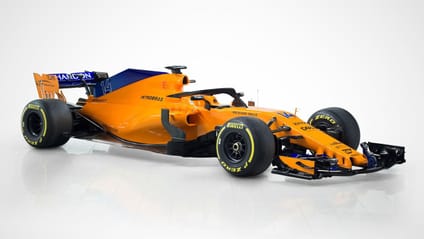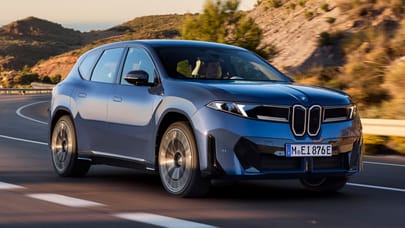
McLaren, Ferrari, Merc-AMG reveal 2018 Formula 1 cars
Keep up to date as the teams announce their contenders for the new season

McLaren MCL33

Here we are then, ladies and gentlemen: McLaren's 2018 Formula 1 contender. A car that simply has to turn the Woking team's fortunes around.
The big news (other than the Halo, of course) is McLaren's move from Honda power to Renault power. In fact, McLaren tells us its the first time in its 52-year history it has run a Renault engine.
Speaking of history, the livery's important too: the papaya orange and blue is a colour scheme first used by McLaren 50 years ago.
As with the remainder of the field, McLaren's efforts for this year's car have been concentrated around adapting the Halo, and packaging up that new Renault power unit. Apparently, "data accumulated from the 2017 season" has fed "a range of improvements".
Star driver Fernando Alonso - you might know him - said: "Looking at our new car, I feel incredibly excited – but also apprehensive. I know just how important this car is to the team, and I just hope that it delivers in the way we all want it to."
He's joined by Stoffel Vandoorne, who noted: "This is an important car; we all know exactly how much rests on it being successful."
Advertisement - Page continues belowScuderia Ferrari SF71H

Meet your 2018 F1 title challenger from Ferrari: the SF71H. The 64th Ferrari F1 single-seater shares much with last year’s car, but Ferrari says (vaguely) it has ‘changed the wheelbase slightly’ and ‘revised the side dimensions along with the cooling system’. Best get your tape measure ready then.
The car weighs 733kg – the 2018 rulebook minimum – and is powered by Ferrari’s own 1.6-litre turbocharged V6 hybrid power unit. Four-time world champion Sebastian Vettel and 2007 world champ Kimi Raikkonen are your drivers, Tifosi.
What do we think to the halo in red, then?
Mercedes-AMG F1 W09 EQ Power+

A big Silverstone shakedown for 2018’s big F1 car: the one everyone has to beat. EQ Power+ refers to Merc’s ongoing hybrid model strategy, and we’re told that over 7,000 ‘drawn parts’ have been built, and more than 40,000 components have been through ‘non-destructive testing inspection’. Yikes.
The new car shares much with last year’s ‘diva’ (though boss Toto Wolff admitted he liked some of the traits of last year’s car, unsurprisingly), with a similar design philosophy. As ever, the Halo, and the banning of both the monkey seat and high T-wings being the most significant changes.
There’s a slightly increased rake over 2017’s car, though it shares the same wheelbase length.
Because of the decrease in engines for this season – just three engines per driver – Merc has gone to work on lifting the reliability and durability of the V6. They’ve changed the packaging, and worked on “combustion efficiency and hardware friction”.
Drivers, as if you need reminding, are reigning – now four-time – world champ Lewis Hamilton, and Valtteri Bottas. Reserve drivers are George Russell and Pascal Wehrlein.
Advertisement - Page continues belowRenault Sport

It’s Renault’s third chassis since they returned to F1 as a factory team, and is, we’re told, a “progression and refinement” of the car we saw last year. Renault has worked on the suspension and downforce, along with reprofiling the engine cover as per the new regs.
Oh, and there’s the protective halo: compulsory for each F1 car this year.
The turbo 1.6-litre Renault power unit has apparently “realised a very strong programme” on the dyno to both better performance and reliability. Tthis year, teams are allowed just three engines per driver, for the whole season.
Drivers for this year? Nico Hulkenberg and Carlos Sainz.
Alfa Romeo Sauber

Heralding Alfa Romeo’s return to Formula 1 – at least in the capacity of backing Sauber – comes the ‘C37’. It marks the return of the Quadrifoglio badge to an F1 car, here applied on the engine cover. Nice.
The C37 gets a Ferrari-powered chassis, and though much is carried over from last year, we’re told this new one features “significantly” improved aero over last year’s contender.
Alfa-Sauber’s driver pairing for 2018 is Marcus Ericsson and Charles Leclerc.
Williams

It’s called the FW41, and though we’re promised a raft of changes underneath, the most striking is the integration of the ‘halo’ safety device.
About those other changes. Paddy Lowe, Williams’ chief technical officer, notes that externally, “the team has pursued a very different aerodynamic concept”. This, in turn, has allowed for “significant progress” in aero performance. We’ll find out next month how both the aero – and that halo – fare on track.
As per last season, the 2018 car will use a Mercedes power unit, tailoring the chassis and body of the new vehicle to make the most of the improved engine.
Haas

This new Haas VF-18 is – as with most – an evolution of 2017's car. Last year, the team finished eighth in the constructors’ championship.
“We eliminated a lot of the variables where we knew we were weak,” explains boss Gene Haas. “We’ve focused on what it’s going to take to get our car to be consistent and close that gap to the top teams.”
And, as with the others, the biggest change is to the aero, a result of installing the halo protection device. “It took quite a bit of study by the aerodynamicists, but the designers had to work hard to modify the chassis so the halo could survive the mandated loads,” Haas adds.
As such, it’s heavier, and there’s a higher centre of gravity than last year, but “everyone is in the same boat”.
Haas’s VF-18 gets a Ferrari engine, with Romain Grosjean and Kevin Magnussen as the driver line-up.
Advertisement - Page continues belowRed Bull

Officially, this is called the Aston Martin Red Bull Racing TAG Heuer RB14. You’ll know it as Red Bull’s 2018 Formula 1 contender.
Paint job first. It’s not the final race livery you’ll see on F1 weekends, merely one it’ll wear for a shakedown at Silverstone. Danny Ricciardo is the man putting the Renault-engined chassis through its paces.
Second up, the halo. We saw it first with the Haas and Williams F1 racers, now we see it here. Says Red Bull: “2018 has a bigger degree of change than most years with the introduction of the Halo and the new exclusion zones on the rear of the car that effectively remove shark fins, monkey seats and T-wings.
“Installing the Halo has been a challenge – mostly in terms of building a chassis strong enough to accommodate it and pass a brutal homologation test,” RB added.
The aforementioned Danny Ric will be joined by Max Verstappen on driving duties.
Trending this week
- Car Review
BMW 1 Series
- Top Gear's Top 9
Nine dreadful bits of 'homeware' made by carmakers







